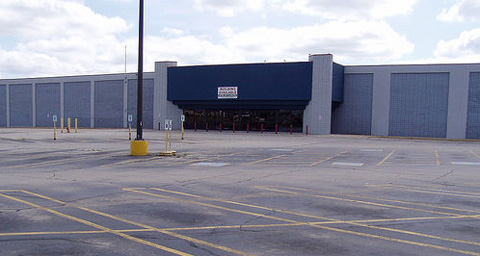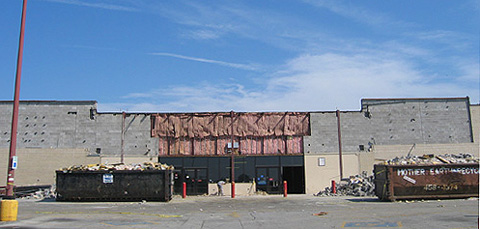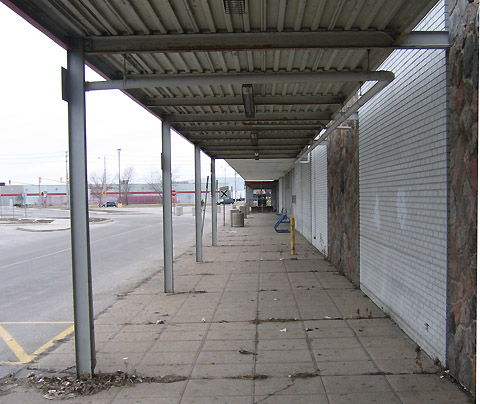by Stacy Mitchell and Jeff Milchen in April 2001 for AMIBA
t's no secret that as corporate chains have taken over much of the retail economy, they've left a wake of half-empty downtowns, shuttered family busnesses and neighborhood residents dependent on driving to strip malls and "big box" stores for staple items.
Now these same chains are dealing communities a second blow: vacating existing stores to build bigger outlets, leaving huge empty shells and acres of asphalt behind.
Dead malls and empty superstores now litter the Western landscape. New Mexico is home to eight empty WalMart carcasses alone. Aurora, Colorado one of five communities with abandoned WalMarts, has two. Both exceed 100,000 square feet--more than twice the size of a football field and three times the size of large supermarket. And that's not counting their vast parking lots.
Alamosa, Colorado, already scarred by an abandoned Kmart, will soon have an empty Walmart, too. The company is doing what Kmart did years ago---moving into an even bigger box down the road.
Chain stores are multiplying at a staggering pace and have created a glut of retail space. Nationwide, fully half a billion square feet of retail space sits empty--the equivalent of about 4,000 shopping malls. In the last 12 years alone, per capita retail space has increased 34 percent, from 15 to 20 square feet. Many communities have more retail space than residents can sup- port, so vacancies inevitably follow.
Compounding the problem, corporate chains reinvent themselves every ten years or so, abandoning existing outlets for new formats. First there were small strip malls, which gave way to enclosed malls, then came successive waves of ever-larger regional malls. Hundreds of malls then closed following the first wave of big box stores in the 1980s. In the 1990s the big boxes themselves began to shed their skins, vacating existing stores to build still larger outlets.\

abandoned WalMart in Beaver Dam, Wisonsin, USA
WalMart is one of the worst offenders with nearly 400 of its stores, many less than a decade old, sitting empty. That's more than 30 million square feet of vacant retail space sur- rounded by thousands of acres of asphalt-the refuse of just one corporation. WalMart plans to "relo- cate" another hundred stores this year as it creates "supercenters", that combine general merchandise and a supermarket under one giant roof.
This wasteful phenomenon not only condemns residents in impacted ommunities, but also has caught the attention of real estate interests. Pricewaterhouse Coopers recently advised investors to shun big box developments, noting that too many already exist and that America is "over-retailed" -- advice worth heeding for any community considering such developments.
Rather than becoming victims of the cor- porate cannibalization game, many communities are taking a different approach.
Some have barred construction of new big box stores and zoned commercial growth into existing developed areas. Others have shifted tax dollars that have long subsidized new roads and other infrastructure for sprawling development into projects that support existing commercial districts.
Such measures require thoughtful land use planning and strong political will, since bringing growth and new business to town continues to exert a powerful allure, regardless of its impact on the community and local economy.
New ways of thinking are emerging too.
In 1998, homegrown businesses in Boulder, Colorado formed the Boulder Independent Business Alliance,a cooperative effort to help each other prosper, and build stronger bonds with the community. The Alliance, now encompassing more than 150 businesses, coordinates group purchasing, joint marketing campaigns to promote the benefits of patronizing locally owned businesses, and political organizing.
Similar alliances have since sprung up in other communities, including Salt Lake City, Utah; Duluth, Minnesota; Austin, Texas and Corvallis, Oregon. Many more towns have formed downtown business partnerships to promote town centers as a destination. A new organization, the American Independent Business Alliance (AMIBA), aims to germinate more such efforts and help knit them together into a national coalition.
The Salt Lake City "Vest Pocket Business Coalition" demonstrated the power of local alliances last summer by playing a pivotal role in stopping taxpayer subsidies for a new mega-mall on the city outskirts. Without the subsidy, the project was ultimately scrapped.

abandoned Walmart in Bardstown, Kenucky, USA
These efforts will pay big dividends in the long run. Unlike footloose superstores, traditional business districts have been around for hundreds of years and can last for hundreds more. Individual businesses may come and go (yesterday's greasy spoon becomes today's espresso bar) but the independent business base itself retains its essential role in the economic and social fabric of the community.
Unlike global corporations, local businesses are owned by people who live in the community and are committed to its well being. These businesses are vital to our quality of life and sense of place, but they face powerful threats, and it requires conscious action to ensure their endurance. Thankfully, many communities are responding to the challenge, realizing that the best community qualities don't come in big boxes.
Stacy Mitchell is a researcher with the Institute for Local Self-Reliance (www.newrules.org) and author of The Home Town Advantage. Jeff Milchen is the founder of the Boulder and American Independent Business Alliances.
Data is from original publication in April 2001 and comes from the WalMart Realty website and the National Trust for Historic Preservation,
Recommended
Resources on this Topic
The
Home Town Advantage
by Stacy Mitchell, 2000
Explores the impacts of chain stores vs. community businesses
and strategies used by communities to promote independent locally
owned business. Highly recommended for those looking for extensive
factual information and examples. $14 paperback available from
AMIBA or the Institute for Local Self Reliance's (ILSR)
New Rules
Project."The New Rules " is their quarterly journal
from the Explores how to move from centralization of power
globally to community building and empowerment. Visit www.newrules.org for
more.
Better,
Not Bigger
by Eben Fodor, 1999
Demonstrates often overooked economic costs of growth and
sprawl while promoting human-scale development.
Slam-Dunking WalMart
by Al Norman.1999
Though the book is geared toward individual struggles to stop single unwanted
big box stores, there's good, broadly applicable organizing information as well.
Also see Norman's website: www.sprawl-busters.com
Up
Against the WalMarts:
How Your Business Can Prosper in the Shadow of the Giants
by Don Taylor and Jeanne Smalling Archer, 1994
An outstanding resource for business owners in all fields. Contains a wealth
of strategies and tactics to help independent businesses compete successfully
with the chains.
AMIBA:
American Independent Business Alliance
222 South Black Ave Bozeman, MT 59715 406-582-1255 i
email: info@AMIBA.net
website: www.AMIBA.net
For more on Big Box impact see:
Island Breath: Kauaifornia
Big Box
Island Breath: Big Box Bill Meeting
Island Breath: Kauaifornia Big Box
Island Breath: Walmart - Always High Prices
Island Breath: Walmart Ditches Xmas
Island Breath: Big Box on Kauai
Island Breath: Big Box Impact Analysis
Island Breath: Mall-Warting America
Island Breath: Big Box Blues
Island Breath: Costco & Kauai Planning
|


